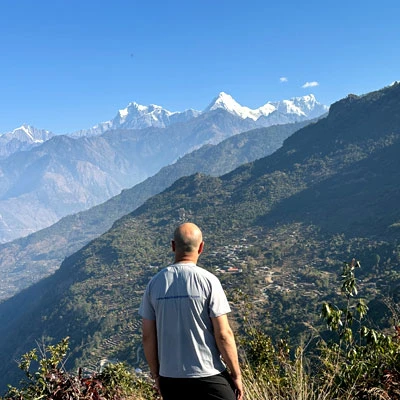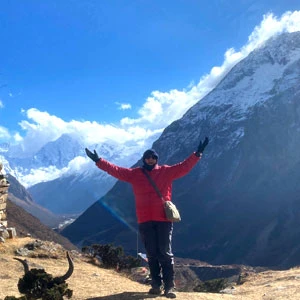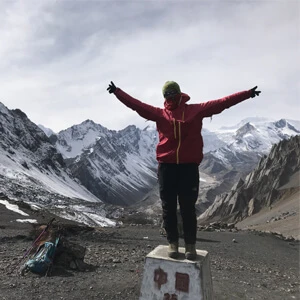Highlights of the Nar Phu Valley Trek
- Experience breathtaking vistas of the Annapurna Himalayas, including peaks like Himlung, Kangaroo, Gangapurna, Annapurna II, Annapurna IV, Annapurna III, and Lamjung Himal.
- Trek through the diverse terrains of the Annapurna Conservation Area and encounter a wide range of flora and fauna, including the rare Himalayan blue sheep.
- Enjoy the tranquility of this less-traveled region, with the constant natural sounds of birds chirping and rivers flowing.
- Spend a day exploring the charm of Phu village and hike to the Himlung Base Camp to witness its impressive glacial surroundings.
- Discover the time-frozen and culturally rich villages of Nar and Phu, each holding centuries-old traditions and Buddhist heritage.
- Challenge yourself with the ascent to Kang La Pass at 5320 meters (17,454 feet).
- Get an amazing chance to spend a night in a monastery and dive into the customs and culture of Tibetan Buddhism.

The untraveled Nar Phu Valley Trek spans around 80 km in the Annapurna region and begins with a scenic drive from Kathmandu to Jagat.
Now, get ready to start the official trek, which begins with an overnight stay in Jagat and a walk to Koto. As you wander along the trail beside the Marsyangdi River, you'll be accompanied by the soothing and dramatic flow of several waterfalls—and trust me, there are several.
Onward from Koto, the trek leads to the eastern part of the valley, crosses a suspension bridge, and continues along the bank of the Nar Phu River. The highlight of the day will be walking through the dense forests of pine, and bamboo, the abundance of waterfalls, and the undisturbed view of Meta village.
In the early morning, after a cup of tea and breakfast, it is time to head to the Phu village, which offers the most memorable ever changing landscapes and unspoiled Tibetan culture. You will be greeted by the beauty of the majestic views of Kangaru Himal and Chyakhu before passing through the village of Kyang.
The trail transitions into a place where time seems to be frozen. The compacted architecture of the buildings on top of one another reminds you of at least the 5th century.
Similarly, the obligatory mani walls, prayer wheels, stupas, and fascinating monastery add charm to your journey. The Phu Village is known as the gateway to the Mt. Himlung (7126 meters) summit and its base camp 4920 meters, adding another adventure for fellow trekkers.
From Phu, the trek returns to Chyakhu and heads towards Nar Phedi. What an exclusive opportunity to spend a night in the Sartek Thrangu Choephel Ling Monastery and immerse yourself in Tibetan Buddhism!
The following day involves a steep climb to the impressively situated village of Nar. The valley is surrounded by jagged peaks like Lamjung Himal and Nemjung Himal, and it cradles the unspoiled Tibetan culture and tradition within its embrace.
The trek through the valley culminates with the climb up to Kang La Pass (5320 meters), from which you can enjoy the best views of Chulu Far East (6429m), Chulu Center, Chulu West (6419m), Annapurna II, Annapurna III, Annapurna IV, Gangapurna, Glacier Dom, Khangsar Kang, Tilicho Peak, etc.
After celebrations on the Kang La Pass, you will head to the steep and rocky descent to Ngawal on the Annapurna Circuit Trail. If your time permits, you can continue on the circuit up to and over Thorong La Pass or head towards Tilicho Lake with the Annapurna Circuit Trek as an alternative. Finally, the trek concludes with a hike back down the trail to Chame and a return drive to Pokhara or Kathmandu.
How difficult is the Nar Phu Valley Trek?
The trek gains significant altitude, starting from an elevation of 1300 meters in Jagat and reaching high passes like Kang La at 5320 meters. As you ascend to over 3000 meters, altitude sickness is a concern. It's crucial to acclimatize properly, stay hydrated, and be aware of the symptoms of altitude sickness.
The trek involves rugged terrain, steep ascents and descents, rocky paths, and narrow trails along deep canyons and gorges. It can be physically demanding and requires good stamina and trekking experience.
Typically, you will cover 12-15 kilometers per day, sometimes up to 20 kilometers. Daily walking hours range from six to seven hours, occasionally longer depending on the terrain and altitude gain.
While the trails are navigable, the remote nature of the trek means facilities and amenities are limited. You'll need to be prepared for basic accommodations and potentially challenging landscapes and Kang La Pass.

Good physical fitness is essential for the Nar Phu Valley trek, as it involves sustained walking over varied terrain and at high altitudes.
Nar Phu Valley Trekking Itinerary
Below is the classic itinerary of Nar Phu Trek. But you can customize it as per your requirements. Our teams are always ready to assist you.
Day 1: Arrival in Kathmandu
Day 2: Free day in Kathmandu
Day 3: Kathmandu to Jagat
Day 4: Jagat to Dharapani
Day 5: Dharapani to Koto
Day 6: Koto to Meta
Day 7: Meta to Phu
Day 8: Explore Himlung Base Camp from Phu
Day 9: Phu to Nar Phedi
Day 10: Nar Phedi to Nar Village
Day 11: Nar to Kang La Pass to Ngawal
Day 12: Ngawal to Chame
Day 13: Drive to Kathmandu or Pokhara
Day 14: Departure
Cultural Experience
Nar and Phu villages are nestled deep within the Nar Phu Valley of Nepal's Manang District. The place offers a profound cultural experience shaped by centuries-old traditions and a remote, "time-frozen" ambiance.
Phu Villages
Phu Village, nestled in the remote reaches of the Nar Phu Valley, exudes a distinctive charm that sets it apart from its counterparts in the region. The village is home to Tibetan communities that are deeply rooted in their cultural practices, which are prominently reflected in their architecture. The sight of monasteries adorned with fluttering prayer flags and the presence of praying monks evoke a sense of spiritual serenity, especially in significant centers like Tashi Lhakhang Monastery.

A highlight of Phu Village is its traditional Tibetan architecture, characterized by sturdy stone houses with flat roofs and intricate carvings. These add to the village's allure and blend harmoniously with the rugged mountain landscape. This architectural style meets the practical demands of mountain living and preserves the community's cultural identity, with the highlight of a timeless connection to their ancestral roots. Phu Village is the gateway to Mt. Himlung summit.
Nar Village
Opened to trekking relatively recently in 2002, Nar Village remains secluded and less frequented by tourists, preserving its tranquil and authentic cultural atmosphere. The village is predominantly inhabited by ethnic Tibetan communities, primarily the Gurung and Ghale people. They have preserved their unique cultural heritage, encompassing language, customs, and religious practices deeply rooted in Tibetan Buddhism.

Nar Village is renowned for its ancient monasteries, including Sartek Monastery located in the Nar Phedi. These monasteries host a variety of religious ceremonies, rituals, and festivals that offer profound insights into the spiritual traditions that have shaped the village over centuries.
You have the opportunity to immerse yourself fully in authentic Himalayan village life. Engaging with locals involved in traditional activities such as farming, yak herding, and craftsmanship provides a firsthand experience of their daily routines and cultural practices.
Planning Your Trek
Now that you're geared up to embark on your Nar Phu Valley Trek, there are several essential aspects to consider for planning a remarkable experience. Understanding these factors will ensure a smooth and enjoyable journey through the remote and culturally rich Nar Phu Valley.
The Best Time to Trek Nar Phu Valley
The Nar Phu Valley Trek offers a distinct experience throughout its different seasons, each characterized by unique weather conditions and landscapes. This ensures that trekkers encounter varying aspects of the region's natural beauty and cultural richness.
Spring (March to May):
Spring is a delightful time to trek in the Nar Phu Valley. The weather is mild, with temperatures ranging from 25°C to 5°C during day time and from 15°C to -15°C during night time at higher elevations. Lower regions experience warmer temperatures, adding to the pleasantness of the trek. One of the highlights of spring is the blooming of rhododendrons, which paint the forests with vibrant colors.
On the other hand, the valley comes alive with bird songs and wildlife activities that enhance the allure of trekking during this season. However, trekkers should be aware that as the season progresses towards the onset of the monsoon in late May, trail conditions may deteriorate due to occasional rain showers.
Autumn (September to November):
Autumn stands out as the prime season for the Nar Phu Valley Trek, regarded by many as the best time to visit. The daytime temperatures reach up to 15°C, and on cool nights, temperatures can drop to around 0°C to -15°C.
The blue sky, excellent views of the snowy white towering peaks, and favorable weather conditions, coupled with lower precipitation levels, describe autumn trekking.
However, as it is the peak season, trekkers may encounter more crowds on popular trails. To enjoy a quieter experience, consider trekking in the early or late autumn months.
Summer (June to August):
During summer, the Nar Phu Valley experiences less rainfall. The fun fact is that the trekking zone lies in a rain shadow area, which means trekking is still feasible despite the rainfall in the surrounding regions. Daytime temperatures can reach up to 25°C, with warm conditions for trekking. Nights are cooler, with temperatures around 5°C, a refreshing contrast after hot days of hiking.
One notable advantage of trekking in summer is the lower number of tourists, which results in a quieter and more peaceful trekking experience. Additionally, summer is a time of cultural celebrations in the monasteries of the Nar Phu Valley. These festivities provide trekkers with a unique opportunity to witness and participate in local traditions.
Winter (December to February):
Winter transforms the Nar Phu Valley into a picturesque snowy landscape with very cold temperatures. Daytime temperatures hover around 4-5°C, while nighttime lows can plummet to -10°C to -20°C or even lower.
The trekking trails, especially the challenging Kang La Pass, become particularly difficult due to slippery conditions and snow accumulation. As a result, trekking in the Nar Phu Valley during winter is not recommended due to safety concerns and logistical challenges.
Nar Phu Valley Trekking Permits:
The Nar Phu Valley Trek is located in a restricted area that requires the assistance of a registered trekking company to obtain the necessary permits. They will ensure compliance with local regulations and facilitate the permit acquisition process There are two permits that trekkers need to secure:
Nar Phu Restricted Area Permit (NPRAP):

It is essential for entering the Nar Phu Valley and obtained from the Immigration Office in Kathmandu and Pokhara. Similarly, the Annapurna Conservation Area trekking permit can be obtained from Nepal Tourism Board Pokhara and Kathmandu.
| Nar Phu Restricted Area Permit (NPRAP) | September to November: $100 for 7 days + $15 per extra day December to August: $75 for 7 days + $10 per extra day |
| Annapurna Conservation Area Project (ACAP) | NPR 3,000 per person |
Accommodation:
Accommodation on the Nar Phu Valley trek consists of teahouses. The basic lodges offer rooms with twin beds or dormitory-style accommodations. Teahouses are along popular trekking routes in Nepal and provide meals and sometimes basic amenities like hot showers and charging outlets. Previously, tea houses served as communal hubs where travelers could rest, eat hearty meals, and socialize. From Jagat to Koto, the accommodation is luxurious with facilities like a shower, Wi-Fi, and charging.
In Phu, the teahouse experience may be more basic compared to other parts of the trek, and due to its remote location, amenities like hot showers might be extra expensive. However, they still offer a cozy place to rest and enjoy meals amidst the mountains.
In Nar Phedi, on the other hand, there are no permanent human settlements. Here, trekkers have the unique opportunity to stay overnight at the Sartek Thangsa Monastery. This allows visitors to immerse themselves in the local Buddhist customs and experience the tranquil atmosphere of this remote religious retreat. After crossing the Kang La pass and reaching the Nwagal you will again get the experience of the luxury accomodation.
Food and Drinks:
On the Nar Phu Valley trek, you can expect a variety of basic local and Tibetan foods available at teahouses and guesthouses along the route. Common meals include Dal Bhat (lentil soup and rice), Tibetan dishes like Champa (barley flour), thenduk (hand-pulled noodle soup), thukpa (noodle soup), potato dishes, and Tibetan bread. A highlight is Tibetan tea, a hearty milk tea with butter and a pinch of salt that helps with altitude and climate adjustment.
While these traditional dishes are readily available, some places also offer pasta and fried noodles. However, due to the remote nature of the trek, you won't find the wide variety of Western food options that are more common on treks, like Everest Base Camp or the Annapurna Circuit.
Essential Gear for Nar Phu Trek
Here's a list of essential gear and items I packed for my trekking adventure:
Clothing:
- Moisture-wicking base layers (synthetic or wool)
- Insulating layers (down jacket)
- Fleece Jacket
- Waterproof and windproof jacket and pants
- Trekking pants and shorts
- 4-5 pairs of light and quick dryer t-shirts
- Thermal underwear (for higher altitudes)
- A sleeping bag rated -20°C
Footwear:
- Sturdy trekking boots with ankle support
- Trekking socks
- Slipper/Flipflop
Headwear:
- Sun hat or cap
- Wool or fleece hat (for warmth)
- Sunglasses with UV protection
Handwear:
- Lightweight gloves (for lower altitudes)
- Insulated gloves or mittens (for higher altitudes)
Backpack:
- Daypack (25-35 liters) for carrying daily essentials
- Backpack 60 to 70 liters
Trekking Accessories:
- Trekking poles (adjustable and collapsible)
- Headlamp or flashlight with extra batteries
- Water bottles or hydration system (2 liters capacity)
- Snacks and energy bars
- Personal first aid kit and toiletries
- Quick-dry towel
- Sunscreen and lip balm with SPF
- Personal medication (if required)
- Lightweight and quick-dry towel
Altitude Sickness:
Altitude sickness is a concern on the Nar Phu Valley Trek due to altitudes exceeding 3,000 meters. Symptoms include headache, nausea, dizziness, and fatigue, potentially leading to more severe conditions like High Altitude Pulmonary Edema (HAPE) or High Altitude Cerebral Edema (HACE).
It's essential to carry medications like Diamox and seek medical assistance if symptoms worsen. To deal with altitude gain, you must acclimatize adequately, stay hydrated, and pace yourself, which aids in prevention. During your Nar Phu Trek your acclimatization stops at Phu Village to help adjust to altitude.
Nepal Trekking Experts provide guides trained in first aid to handle emergencies and accidents and ensure proper care if needed.
Note: Besides the classic itinerary, consider adding an extra day or two to your trekking journey to acclimatize to the altitude and minimize altitude sickness if you have flexibility.
Insurance
Obtaining travel insurance is crucial for the Nar Phu Valley trek. It covers medical emergencies and helicopter evacuation if needed due to altitude sickness or accidents. Additionally, it's advisable to confirm coverage details thoroughly to ensure it meets all trekking needs, including missed flights or unexpected delays. Understanding the policy will help you prepare for any unforeseen circumstances during your trek.
Estimated Cost for Nar Phu Valley Trek
| Expense Category | Estimated Cost: |
| Guide | $30 a day |
| Porter | $25 a day |
| Meal | $35 a day per person |
| Transportation | Kathmandu to Jagat (private jeep) : $250 Chame to Kathmandu (private jeep) : $300 Kathmandu to Jagat (public vehicle, roundtrip): $75 per person |
| Hotel in Kathmandu | $40 to $50 for a decent 3 star hotel per night |
Conclusion
The Nar Phu Valley trek promises an unforgettable adventure through remote Himalayan landscapes and vibrant Tibetan culture. From the serene Phu Village to the spiritual retreat at Nar Phedi, trekkers will discover breathtaking scenery and rich traditions. Prepare well with the right gear, travel insurance, and acclimatization strategies to enjoy this rewarding journey safely. Embrace the challenge, soak in the cultural experiences, and savor the sense of accomplishment in completing this remarkable trek.
For expert guidance and support in planning your Nar Phu Valley Trek, contact Nepal Trekking Experts for a well-prepared and enjoyable trekking experience in Nepal's stunning landscapes.
Nar Phu Valley Trek FAQS
Here are some of the most asked questions about the Nar Phu Valley Trek.
How difficult is the Nar Phu Valley Trek?
The Nar Phu Valley Trek is considered challenging. It involves steep ascents, high altitudes, and long trekking days. Physical fitness and prior trekking experience are recommended.
Do I need a special permit for the Nar Phu Valley Trek?
Yes, trekkers need a special Restricted Area Permit (ACAP) for the Nar Phu Valley and the Annapurna Conservation Area Permit (ACAP).
What kind of accommodation is available on the trek?
Accommodation along the trek typically consists of tea houses. The Annapurna part of the trail provides a luxury trekking facility, whereas in the remote trail of Nar and Phu, there are basic lodges with essential amenities like meals and sleeping quarters. Some areas might also have the option to stay in monasteries.
How do I prepare for the Nar Phu Valley Trek?
Preparation should include cardiovascular and strength training exercises, such as hiking, running, and leg workouts. Additionally, gradually increasing your altitude exposure can help acclimatization. Ensuring you have the right gear, like sturdy hiking boots, warm clothing, and a good quality sleeping bag, is essential.
For further queries do not hesitate to contact our local specialist.












